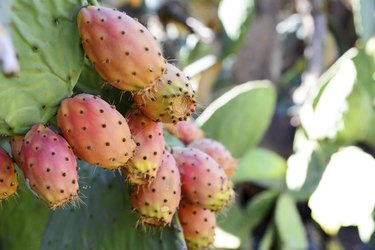
Barbed spines and a vigorous spreading habit make prickly pear cactus (Opuntia spp.) a nuisance in gardens. About 60 varieties are in the prickly pear genus, and they include Opuntia compressa, which is hardy in U.S. Department of Agriculture plant hardiness zones 4 through 9, and Opuntia macrorhiza, which is hardy in USDA zones 3 through 9. Most varieties spread through pads that break off and form new plants. Using particular techniques, however, can keep prickly pear cactus plants from spreading and kill them.
Dig Deep
Video of the Day
Cutting prickly pear cacti roots below the soil surface kills the plants. Putting on a long-sleeved shirt, long pants, leather gloves and safety glasses or goggles before approaching prickly pear cacti will protect you from the plants' sharp spines and bristles as you work with the cacti. On a hot, dry day, push a grubbing hoe or sharp spade into the soil until it is 2 to 4 inches below the soil surface, and use the tool to cut through all of the prickly pear roots. Remove all of the cacti's parts from the area. Place all the plant debris in a thick, plastic bag, and throw the bag in the trash. Prickly pear parts left on the ground can become new plants.
Video of the Day
Limit the Spread
Good garden hygiene prevents prickly pear cacti from spreading. Prickly pears spread to other parts of a garden when their pads and seeds hitch a ride on clothing and gardening equipment. Inspect your clothing and gardening tools after you remove prickly pear cacti, and -- while wearing leather gloves -- pick off all seeds and other plant debris; dispose of them in a thick, plastic bag and place the bag in the trash. The clothing and tools need to be washed thoroughly. Don't mow areas infested with prickly pear cacti because doing so spreads the plants.
Follow Up
Successful prickly pear cactus control involves aftercare of an area they previously infested. Because prickly pears thrive in hot, dry conditions, reduce the chances of the plants re-growing in the area by watering the site thoroughly and spreading a 3-inch-thick layer of organic mulch, such as well-rotted manure, garden compost, wood chips or leaf mold, on the ground. Apply water regularly so that the site's soil remains moist. Checking for new plants weekly and pulling up all of them that appear is essential; wear protective clothing when you remove the new plants. An alternative aftercare method is to cover the area with weed-suppressing landscape fabric and an organic or inorganic mulch, such as gravel or pebbles.
Explore Options
High-strength herbicides control prickly pear cactus, but the options are limited for home gardeners. Herbicides that treat prickly pear infestations also kill grass and desired plants, and they can leach into groundwater and persist in the soil. After sprayed with herbicide, prickly pear plants take six to eight months to show any effect and two to three years before their infestation is finally controlled. Treating prickly pears with herbicides is a job for professional contractors, who are licensed to use the required herbicides and trained how to use them safely.
- Missouri Botanical Garden: Opuntia Compressa
- U.S Department of Agriculture, Forest Service, Southwest Region: Field Guide for Managing Prickly Pear in the Southwest
- University of Florida IFAS Extension: Prickly Pear Cactus Control in Pastures
- Missouri Botanical Garden: Opuntia Macrorhiza
- Purdue Extension: A Prickly Situation That Prickly Pear
- University of California Cooperative Extension: Prickly Pear Cactus Production
- Native Plant Society of Texas: Prickly Pear Cactus, Our State Plant